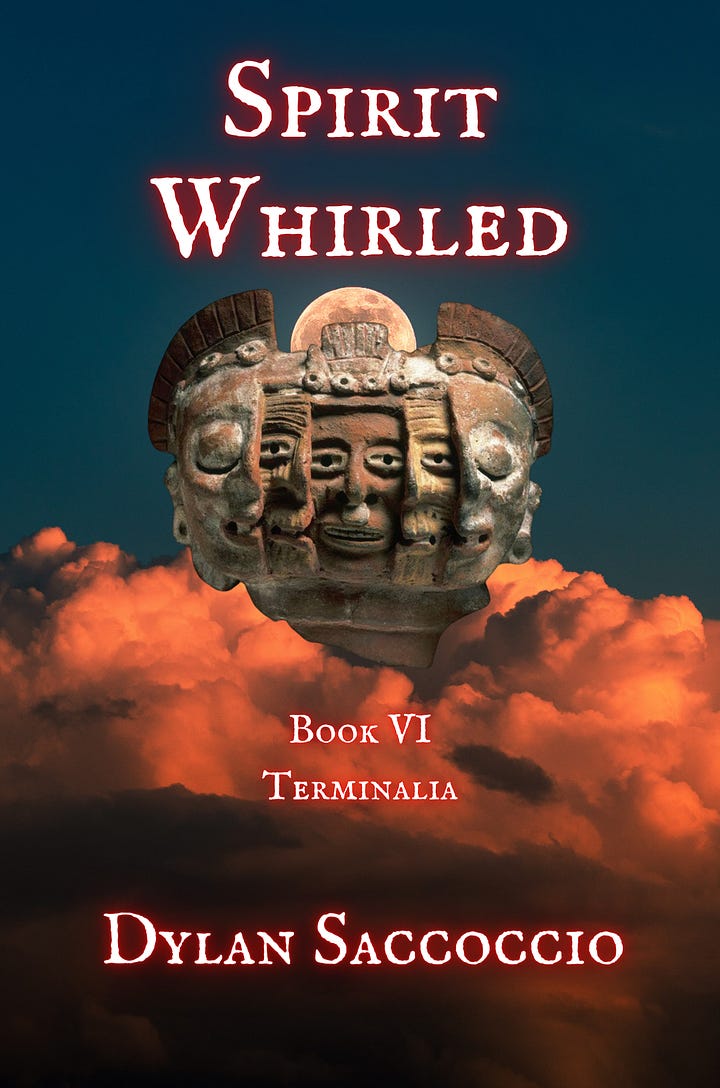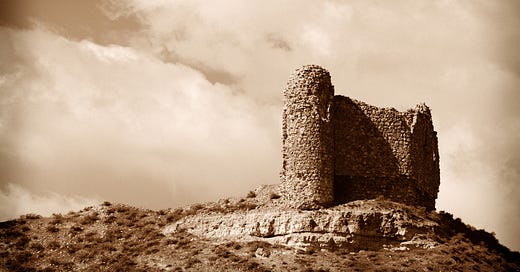Fresh Batch #188: Worship Paid at Caverns & High Places
Omphalos, Its Mistranslation as Navel, & Its Corruption as Olympus, The Fall of Hermes from Oracle to Messenger, and Bryant's Pompeii Etymology
Reminder: All articles can be listened to through the Substack app for those who don’t prefer to read. Also, if you have questions or ideas you’d like me to address about this article, feel free to post them in the Substack app. If I can, I’ll address it in a livestream on Substack.
Caverns
There are accounts regarding the nature of worship beginning in caverns initially, until mankind was sophisticated enough to build temples around the caverns. However, the written accounts aren’t from the times prior to mankind being sophisticated enough to build temples, which makes them unsatisfactory as evidence. But generally speaking, there is archaeological evidence to support the claims, so I’m comfortable with these conclusions. However, the details regarding the dating of some of the locations is questionable. But we can see the cavernous nature of even things like the edifices in ancient Egypt, as well as at Petra. In Italy, one needn’t look further than the caves of the Sibyls or the catacombs of the Cathedrals.
Mountains
I am of the opinion, that generally speaking, when you see historical accounts dealing with mountains and caves in the same story, that you should be aware of the possibility of allegory: the cavern being the winter solstice and the peak of a mountain being the summer one. However, it is quite popular for important edifices, be they religious or palatial, to have been erected on high mountains or bluffs. The views are incredible, which usually lend themselves to seeing foreign advances. But there is a spiritual component to being up high like that, being closer to heaven and looking down upon the world from the perspective of a god, as most lords represent themselves.
Bryant wrote (Analys. Anc. Myth. pp. 238-39.), “This practice in early times was almost universal; and every mountain was esteemed holy. The people, who prosecuted this method of worship, enjoyed a soothing infatuation, which flattered the gloom of superstition. The eminences to which they retired were lonely, and silent; and seemed to be happily cirumstanced for contemplation and prayer. They, who frequented them, were raised above the lower world; and fancied that they were brought into the vicinity of the powers of the air, and of the Deity who resided in the higher regions. But the chief excellence for which they were frequented, was the Omphi, expressed ομφη (omphi), by the Greeks, and interpreted Θεια κληδων (Theia kledon), vox divina (divine voice), being esteemed a particular revelation from heaven. (Ομφη, θεια κληδων. Hesych. It was sometimes expressed without the aspirate, αμβη: hence the place of the oracle was styled Ambon, αμβων. Αμβων, άι προσαναβασεις των ορων. Hesych.) In short they were looked upon as the peculiar places where God delivered his oracles. Hermæus in Plutarch expresses this term ομφις, omphis; and says, that it was the name of an Egyptian Deity: and he interprets it, I know not for what reason, ευεργετης (euergetes; benefactor). The word truly rendered was Omphi or Amphi, the oracle of Ham; who, according to the Egyptian theology, was the same as the Sun, or Osiris. He was likewise revered as the chief Deity by the Chaldeans; and by most nations in the east. He was styled both Ham, and Cham: and his oracles both Omphi and Ompi. In consequence of this the mountains, where they were supposed to be delivered, came to be denominated Har-al-Ompi; which al-ompi by the Greeks was changed to Ολυμπος, Olympus; and the mountain was called ορος Ολυμπου (oros Olympou). There were many of this name. The Scholiast upon Apollonius reckons up six (Ολυμποι εισιν έξ–κλ. There are six Olympians, etc. Scholia upon Apollonius Rhodius. L. 1. v. 598.): but there were certainly more, besides a variety of places styled upon the same account Olympian. (Many places are styled Olympus and Olympian. In Lycia: Ολυμπος μεγαλη πολισ, και όροσ όμωνυμον. Olympus, a great city and a mountain of the same name. Strabo. L. 14. p. 982. Ολυμπη πολις Ιλλυριας. Olympus, city in Illaria. Stephanus Byzantiunus. In Cyprus: Ἀμαθοῦς πόλις καὶ μεταξὺ πολίχνη Παλαιὰ καλουμένη, καὶ ὄρος μαστοειδὲς Ὄλυμπος. Next is the city Amathus, and between Citium and Berytus, a small city called Palæa, and a pap-shaped mountain, Olympus. Strabo. L. 14. p. 1001. ἡ δ᾽ ἀκρώρεια καλεῖται Ὄλυμπος. The extremity is called Olympus. Strabo. Ib. Josephus mentions the temple of Olympian Zeus at Tyre. Antiq. Jud. L. 8. c. 1. At Megara in Greece: Τεμενος Ολυμπειον. Olympian Sacred Enclosure [Temple]. Pausanias. L. 1. p. 97. In Elis: Ή Ολυμπια πρωτον Κρονιος λοφος ελεγετο. It was said that Olympia was the first divine emanation of wisdom [logos] from Time [Kronos]. Scholia upon Lycophron. v. 42. In Attica: Ναος Κρονου, και ’Ρεας, και τεμενος την επικλησιν Ολυμπιας. The temple of Kronos, and Rhea, was the sacred enclosure where Olympia was invoked. Pausan. L. 1. p. 43. In Achaia: Διος Ολυμπιου ναος. Temple of the Olympian Zeus. Pausan. L. 2. p. 123. At Delos: Ολυμπειον, τοπος εν Δηλω. Olympia, a place in Delos. Stephanus Byzantinus. Εστι και πολις Παμφυλιας. And it’s also the city in Pamphylia. Libya was called Olympia. Stephanus Byzant. The moon called Olympias: Ή γαρ Σεληνη παρ’ Αιγυπτιοις κυριως Ολυμπιας καλειτα. The Moon Goddess [Selene] was called the Lady [Lord] of Olympia by the Egyptians. Eusebii Chron. p. 45. L. 10. The earth itself called Olympia by Plutarch, who mentions της Γης Ολυμπιας ίερον, the Earth of Olympia is holy, in Theseus, by which is meant the temple of the Prophetic Earth. It might be translated as Olympia, the Temple of Earth. Many other instances might be produced.)
I’m not going to pull all of the above quotes, but here are a few from Strabo to help you find them easily:
Bryant continued (Ib. p. 240.), “They were all looked upon to be prophetic; and supposed to be the residence of the chief Deity, under whatever denomination he was specified, which was generally the God of light. For these oracles no place was of more repute than the hill at Delphi, called Omphi-El, or the oracle of the Sun. But the Greeks, who changed Al-omphi to Olympus, perverted these terms in a manner still more strange: for finding them somewhat similar in sound to a word in their own language, their caprice immediately led them to think of ομφαλος (omphalos), a navel, which they substituted for the original word. This they did uniformly in all parts of the world; and always invented some story to countenance their mistake. Hence, whenever we meet with an idle account of a navel, we may be pretty sure that there is some allusion to an oracle.”
Regardless of whether this is true or not, the tradition is carried to the modern day churches, where the nave is their central part which the congregation sits, similar to crews in ancient ships, hence the word naval. The maritime and priestly influences cannot be separated from each other in this system.
Bryant continued (Ib. pp. 240-41.), “In respect to Delphi, they presumed that it was the umbilicus, or center of the whole earth. The poets gave into this notion without any difficulty: Sophocles calls it μεσομφαλα Γης μαντεια (the epicenter of Earth’s oracles/priests. Sophocles: Œdipus Tyrannus. v. 487.): and Euripides avers that it was the precise center of the earth: Οντως μεσον ομφαλον γας Φοιβου κατεχει δομος. (In fact, there is a structure in the middle of the navel of Phoebus [the god of light; Apollo; the sun]. Euripides in Ione. v. 233.)
I’ve treated these subjects extensively in the Spirit Whirled series, and then I address the practicality of the universal system that’s been covered-up or forgotten about, leading up to the degraded version of this system in the so-called Common Era, in The Real Universal Empire.







Become a member to access the rest of this article.
Keep reading with a 7-day free trial
Subscribe to Ancient History, Mythology, & Epic Fantasy to keep reading this post and get 7 days of free access to the full post archives.








